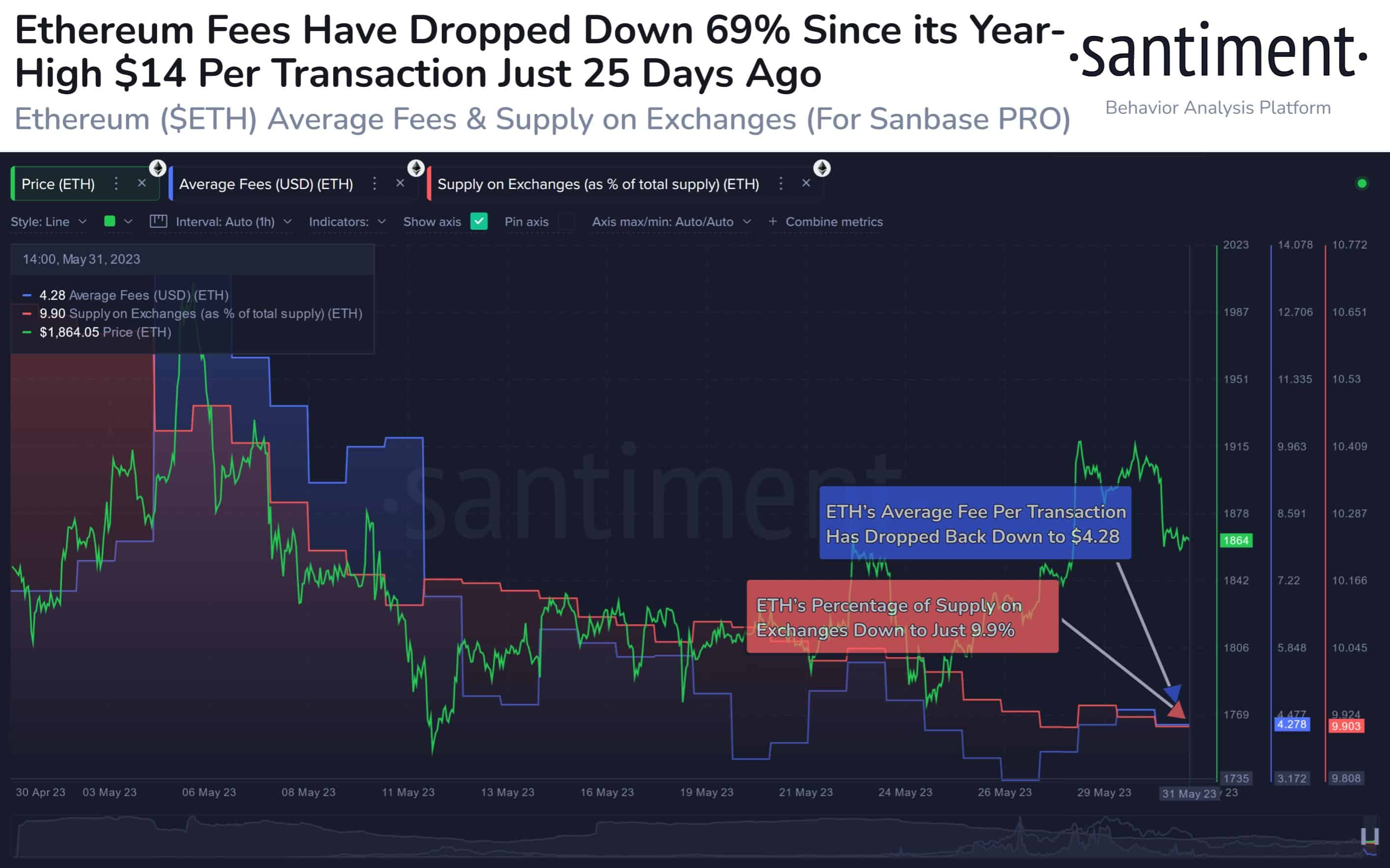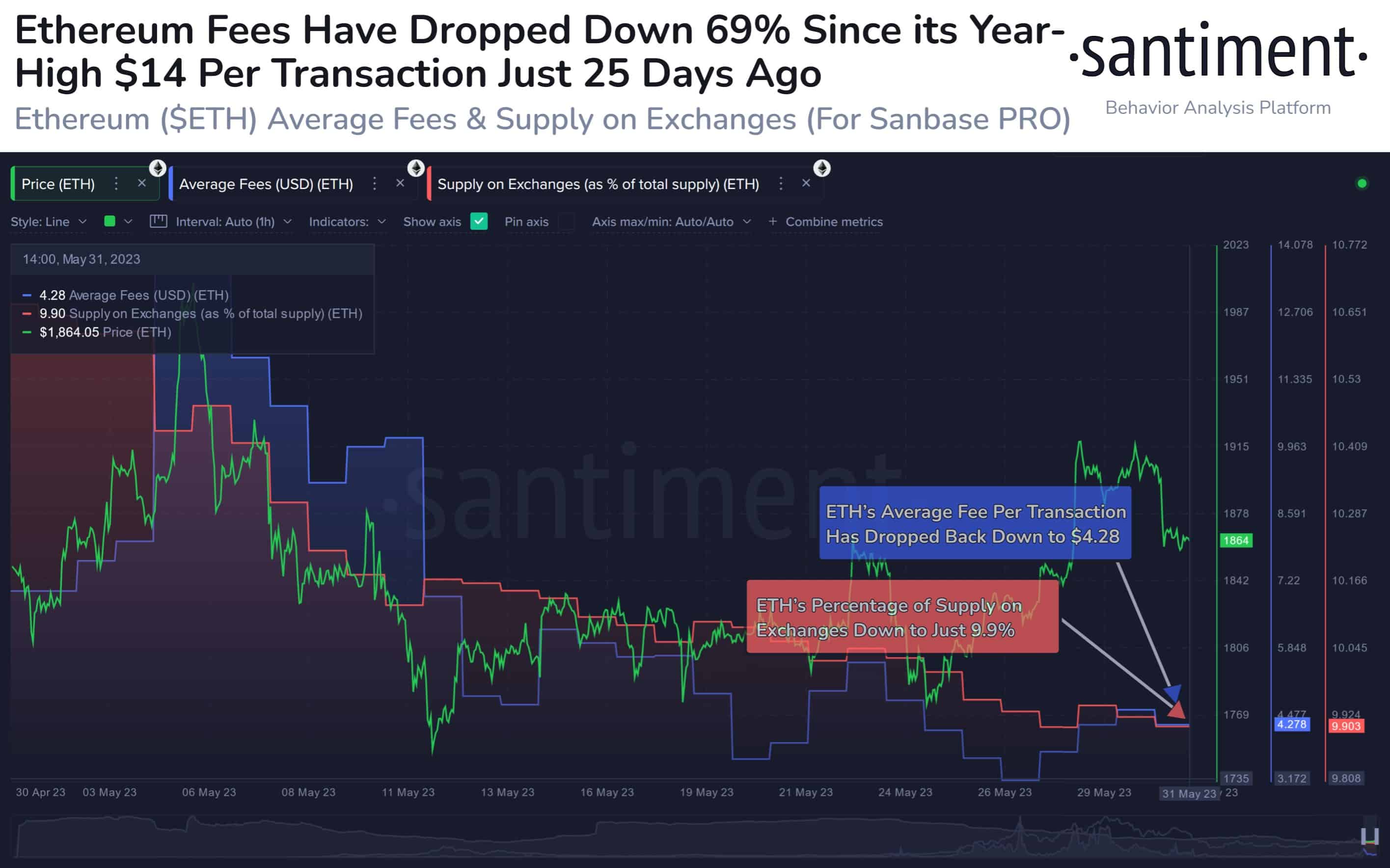Ethereum Average Gas Fee Dropped 69% Over Last Month, Will ETH Surge?

The world’s second-largest cryptocurrency Ethereum (ETH) ended the last month of May 2023 on a pretty flattish note and is currently trading around $1,850 levels. However, the last month witnessed some important changes in terms of the drop in the transaction gas fee.
As per on-chain data provider Santiment, Ethereum’s (ETH) gas fee dropped by nearly 70% within just a month’s time. Interestingly, in early May last month, the Ethereum gas fee touched its 2023 high of $14. However, by the end of the month, it dropped all the way to under $5. In its report, Santiment notes:
Ethereum’s average fees have come back down to earth after its 2023-high $14 per $ETH transaction in early May. More affordability encourages more utility. Additionally, #crypto‘s #2 asset is at an #alltimelow 9.9% on exchanges as #selfcustody reigns.

Courtesy: Santiment
Ethereum Gas Usage By Transaction Types
Since the Ethereum blockchain has been host to several asset classes for a very long time, each of them has contributed to gas price surges at different points in time.
On-chain crypto analysts platform Glassnode explains how different asset classes were leading contributors to Ethereum gas prices at different times. Back in 2017-2018, ICOs were at their peak contributing 40% of the gas on Ethereum and attributed to all the ERC-20 token transfers.
However, as the demand for the ERC-20 tokens started to decline in the later years, decentralized finance (DeFi) rose to prominence in 2020. The DeFi wave reached its peak in June 2020 to 2021, contributing a 30% gas fee. Glassnode highlights the consistent underperformance in the DeFi tokens over the last two years adding “investments into DeFi have been complex, recording remarkably poor token price performance over the recent years”.
Later since mid-2021, non-fungible tokens (NFTs) gained major prominence while the demand was subdued by the end of 2022. Similarly, the USD-pegged stablecoins have experienced a surge in user demand since 2020. Glassnode explains: “The decrease in gas usage from stablecoin transactions reflects a shift in their change in utility more than a decrease in demand. Stablecoins are now used less as a payment method but more for hedging and as a store of value”.

Courtesy: Santiment







 Bitcoin
Bitcoin  Ethereum
Ethereum  Tether
Tether  USDC
USDC  Dogecoin
Dogecoin  Cardano
Cardano  TRON
TRON  Bitcoin Cash
Bitcoin Cash  Chainlink
Chainlink  Polygon
Polygon  Litecoin
Litecoin  Dai
Dai  LEO Token
LEO Token  Ethereum Classic
Ethereum Classic  Hedera
Hedera  Cronos
Cronos  Cosmos Hub
Cosmos Hub  Stellar
Stellar  OKB
OKB  Stacks
Stacks  Maker
Maker  Monero
Monero  Theta Network
Theta Network  Algorand
Algorand  NEO
NEO  Gate
Gate  KuCoin
KuCoin  EOS
EOS  Tezos
Tezos  Synthetix Network
Synthetix Network  IOTA
IOTA  Bitcoin Gold
Bitcoin Gold  Tether Gold
Tether Gold  TrueUSD
TrueUSD  Zilliqa
Zilliqa  Enjin Coin
Enjin Coin  Holo
Holo  Ravencoin
Ravencoin  0x Protocol
0x Protocol  Siacoin
Siacoin  Qtum
Qtum  Basic Attention
Basic Attention  Zcash
Zcash  Dash
Dash  NEM
NEM  Decred
Decred  Ontology
Ontology  Lisk
Lisk  Waves
Waves  DigiByte
DigiByte  Numeraire
Numeraire  Nano
Nano  Status
Status  Pax Dollar
Pax Dollar  Hive
Hive  Steem
Steem  Huobi
Huobi  OMG Network
OMG Network  BUSD
BUSD  Ren
Ren  Bytom
Bytom  Bitcoin Diamond
Bitcoin Diamond  Kyber Network Crystal Legacy
Kyber Network Crystal Legacy  Augur
Augur  Energi
Energi  HUSD
HUSD